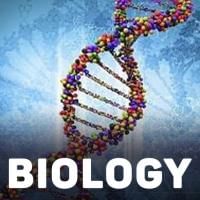NEET Exam > NEET Questions > Some amino acids are coded by more than one c...
Start Learning for Free
Some amino acids are coded by more than one codon, hence the genetic code is
- a)overlapping
- b)degenerate
- c)wobbled
- d)unambiguous
Correct answer is option 'B'. Can you explain this answer?
Most Upvoted Answer
Some amino acids are coded by more than one codon, hence the genetic c...
Since there are 64 triplet codons and only 20 amino acids, the incorporation of some amino acids must be influenced by more than one codon. Only tryptophan (UGG) and methionine (AUG) are specified by single codons. All other amino acids are specified by two (e.g., phenylalanine UUU, UUC) to six (e.g., arginine CGU, CGC, CGA, CGG, AGA, AGG) codons. The latter are called degenerate or redundant codons. In degenerate codons, generally, the first two nitrogen bases are similar while the third one is different. As the third nitrogen base has no effect on coding, the same is called wobble position.
Free Test
FREE
| Start Free Test |
Community Answer
Some amino acids are coded by more than one codon, hence the genetic c...
Explanation:
The genetic code is a set of rules by which the DNA or mRNA sequence is translated into the amino acid sequence in a protein. Each amino acid is represented by a sequence of three nucleotides called codons. However, there are more codons than there are amino acids, which means that some amino acids are coded by more than one codon. This property of the genetic code is referred to as degeneracy.
Reasons for degeneracy:
The degeneracy of the genetic code has several reasons:
1. Redundancy: There are 20 different amino acids but only four different nucleotides (A, T/U, G, C). Since each codon is composed of three nucleotides, there are a total of 64 possible codons (4^3). Therefore, multiple codons can code for the same amino acid, leading to redundancy or degeneracy.
2. Protective mechanism: Degeneracy provides a protective mechanism against mutations. Mutations in the DNA sequence can lead to changes in a codon, but if the codon still codes for the same amino acid, the resulting protein may not be functionally affected.
3. Evolutionary advantage: Degeneracy allows for more flexibility in the genetic code. It provides a buffer against errors in DNA replication or transcription, as well as allowing for adaptation to changing environmental conditions.
Examples:
Some examples of degeneracy in the genetic code include:
1. The amino acid leucine is coded by six different codons: UUA, UUG, CUU, CUC, CUA, and CUG.
2. The amino acid serine is coded by six different codons: UCU, UCC, UCA, UCG, AGU, and AGC.
3. The amino acid arginine is coded by six different codons: CGU, CGC, CGA, CGG, AGA, and AGG.
Significance:
The degeneracy of the genetic code allows for redundancy and flexibility, which is important for several biological processes:
1. Translation efficiency: Multiple codons coding for the same amino acid allow for faster and more efficient protein synthesis.
2. Evolutionary adaptation: The degeneracy of the genetic code allows for the accumulation of genetic variations over time, leading to the evolution of new traits and species.
3. Genetic engineering: The ability to use different codons to code for the same amino acid is utilized in genetic engineering techniques to optimize protein expression in various organisms.
In conclusion, the genetic code is degenerate because some amino acids are coded by more than one codon. This degeneracy provides redundancy, protection against mutations, and flexibility in the genetic code, allowing for efficient protein synthesis and evolutionary adaptation.
The genetic code is a set of rules by which the DNA or mRNA sequence is translated into the amino acid sequence in a protein. Each amino acid is represented by a sequence of three nucleotides called codons. However, there are more codons than there are amino acids, which means that some amino acids are coded by more than one codon. This property of the genetic code is referred to as degeneracy.
Reasons for degeneracy:
The degeneracy of the genetic code has several reasons:
1. Redundancy: There are 20 different amino acids but only four different nucleotides (A, T/U, G, C). Since each codon is composed of three nucleotides, there are a total of 64 possible codons (4^3). Therefore, multiple codons can code for the same amino acid, leading to redundancy or degeneracy.
2. Protective mechanism: Degeneracy provides a protective mechanism against mutations. Mutations in the DNA sequence can lead to changes in a codon, but if the codon still codes for the same amino acid, the resulting protein may not be functionally affected.
3. Evolutionary advantage: Degeneracy allows for more flexibility in the genetic code. It provides a buffer against errors in DNA replication or transcription, as well as allowing for adaptation to changing environmental conditions.
Examples:
Some examples of degeneracy in the genetic code include:
1. The amino acid leucine is coded by six different codons: UUA, UUG, CUU, CUC, CUA, and CUG.
2. The amino acid serine is coded by six different codons: UCU, UCC, UCA, UCG, AGU, and AGC.
3. The amino acid arginine is coded by six different codons: CGU, CGC, CGA, CGG, AGA, and AGG.
Significance:
The degeneracy of the genetic code allows for redundancy and flexibility, which is important for several biological processes:
1. Translation efficiency: Multiple codons coding for the same amino acid allow for faster and more efficient protein synthesis.
2. Evolutionary adaptation: The degeneracy of the genetic code allows for the accumulation of genetic variations over time, leading to the evolution of new traits and species.
3. Genetic engineering: The ability to use different codons to code for the same amino acid is utilized in genetic engineering techniques to optimize protein expression in various organisms.
In conclusion, the genetic code is degenerate because some amino acids are coded by more than one codon. This degeneracy provides redundancy, protection against mutations, and flexibility in the genetic code, allowing for efficient protein synthesis and evolutionary adaptation.

|
Explore Courses for NEET exam
|

|
Similar NEET Doubts
Some amino acids are coded by more than one codon, hence the genetic code isa)overlappingb)degeneratec)wobbledd)unambiguousCorrect answer is option 'B'. Can you explain this answer?
Question Description
Some amino acids are coded by more than one codon, hence the genetic code isa)overlappingb)degeneratec)wobbledd)unambiguousCorrect answer is option 'B'. Can you explain this answer? for NEET 2025 is part of NEET preparation. The Question and answers have been prepared according to the NEET exam syllabus. Information about Some amino acids are coded by more than one codon, hence the genetic code isa)overlappingb)degeneratec)wobbledd)unambiguousCorrect answer is option 'B'. Can you explain this answer? covers all topics & solutions for NEET 2025 Exam. Find important definitions, questions, meanings, examples, exercises and tests below for Some amino acids are coded by more than one codon, hence the genetic code isa)overlappingb)degeneratec)wobbledd)unambiguousCorrect answer is option 'B'. Can you explain this answer?.
Some amino acids are coded by more than one codon, hence the genetic code isa)overlappingb)degeneratec)wobbledd)unambiguousCorrect answer is option 'B'. Can you explain this answer? for NEET 2025 is part of NEET preparation. The Question and answers have been prepared according to the NEET exam syllabus. Information about Some amino acids are coded by more than one codon, hence the genetic code isa)overlappingb)degeneratec)wobbledd)unambiguousCorrect answer is option 'B'. Can you explain this answer? covers all topics & solutions for NEET 2025 Exam. Find important definitions, questions, meanings, examples, exercises and tests below for Some amino acids are coded by more than one codon, hence the genetic code isa)overlappingb)degeneratec)wobbledd)unambiguousCorrect answer is option 'B'. Can you explain this answer?.
Solutions for Some amino acids are coded by more than one codon, hence the genetic code isa)overlappingb)degeneratec)wobbledd)unambiguousCorrect answer is option 'B'. Can you explain this answer? in English & in Hindi are available as part of our courses for NEET.
Download more important topics, notes, lectures and mock test series for NEET Exam by signing up for free.
Here you can find the meaning of Some amino acids are coded by more than one codon, hence the genetic code isa)overlappingb)degeneratec)wobbledd)unambiguousCorrect answer is option 'B'. Can you explain this answer? defined & explained in the simplest way possible. Besides giving the explanation of
Some amino acids are coded by more than one codon, hence the genetic code isa)overlappingb)degeneratec)wobbledd)unambiguousCorrect answer is option 'B'. Can you explain this answer?, a detailed solution for Some amino acids are coded by more than one codon, hence the genetic code isa)overlappingb)degeneratec)wobbledd)unambiguousCorrect answer is option 'B'. Can you explain this answer? has been provided alongside types of Some amino acids are coded by more than one codon, hence the genetic code isa)overlappingb)degeneratec)wobbledd)unambiguousCorrect answer is option 'B'. Can you explain this answer? theory, EduRev gives you an
ample number of questions to practice Some amino acids are coded by more than one codon, hence the genetic code isa)overlappingb)degeneratec)wobbledd)unambiguousCorrect answer is option 'B'. Can you explain this answer? tests, examples and also practice NEET tests.

|
Explore Courses for NEET exam
|

|
Signup for Free!
Signup to see your scores go up within 7 days! Learn & Practice with 1000+ FREE Notes, Videos & Tests.


























